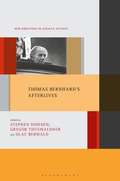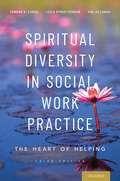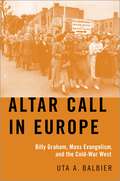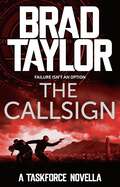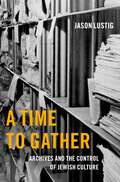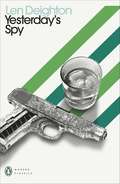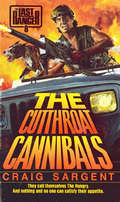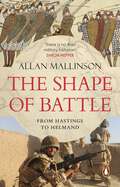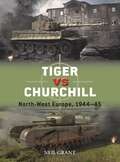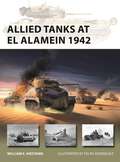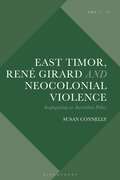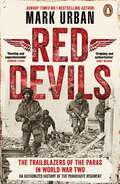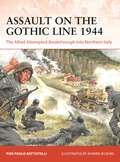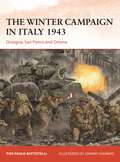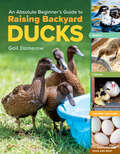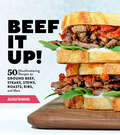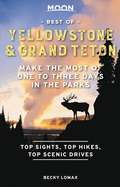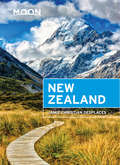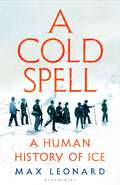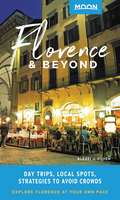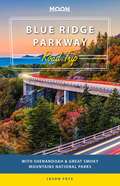- Table View
- List View
Liminal Spaces: Migration and Women of the Guyanese Diaspora
by Grace Aneiza AliLiminal Spaces is an intimate exploration into the migration narratives of fifteen women of Guyanese heritage.
Liminal Spaces: Migration and Women of the Guyanese Diaspora
by Grace Aneiza AliLiminal Spaces is an intimate exploration into the migration narratives of fifteen women of Guyanese heritage.
Thomas Bernhard's Afterlives (New Directions in German Studies)
by Stephen Dowden, Gregor Thuswaldner, and Olaf BerwaldIn his prose fiction, memoirs, poetry, and drama, Thomas Bernhard (1931-1989)--one of the 20th century's most uniquely gifted writers--created a new and radical style, seemingly out of thin air. His books never “tell a story” in the received sense. Instead, he rages on the page, he rants and spews vitriol about the moral failures of his homeland, Austria, in the long amnesiac aftermath of the Second World War. Yet this furious prose, seemingly shapeless but composed with unparalleled musicality, and taxing by conventional standards, has been powerfully echoed in many writers since Bernhard's death in 1989. These explorers have found in Bernhard's singular accomplishment new paths for the expression of life and truth.Thomas Bernhard's Afterlives examines the international mobilization of Bernhard's style. Writers in Italian, German, Spanish, Hungarian, English, and French have succeeded in making Bernhard's Austrian vision an international vision. This book tells that story.
Spiritual Diversity in Social Work Practice: The Heart of Helping
by Hwi-Ja Canda Edward R, Canda Leola Dyrud FurmanSocial workers and helping professionals serve many people who draw upon religion and spirituality to find meaning, thrive, and overcome oppression and obstacles in their lives. The third edition of Spiritual Diversity in Social Work Practice provides a comprehensive framework of values, knowledge, and skills for spiritually sensitive and culturally appropriate practice with diverse religious and non-religious clients. This classic text contains forty different case examples and stories that vividly illustrate the professional values and ethical principles that guide spiritually sensitive practice. Learning activities at the end of each chapter encourage readers' personal and professional development through self-reflection, dialogue, creative expression, outreach to the community, and skill application. The book also draws connections between spiritual and cultural diversity, gender, and LGBTQI issues. It introduces beliefs, values, and social welfare applications of Buddhism, Christianity, Confucianism, Hinduism, Indigenous spiritual perspectives, Islam, Judaism, Existentialism, and Transpersonal and Deep Ecological Theories. Skills for spiritual assessment and spiritually sensitive practices include mindfulness, meditation, ritual and ceremony, forgiveness, spiritually sensitive administration, and engagement with community-based spiritual support systems. For social workers and other professional helpers committed to supporting the spiritual care of individuals, families, and communities, this definitive guide offers state-of-the-art interdisciplinary and international insights as well as practical tools that students and practitioners alike can put to immediate use.
Trade Mark Law in Europe 3e
by Alexander von Mühlendahl Dimitris Botis Spyros Maniatis Imogen WisemanIn light of the ever-growing and developing jurisprudence of the Court of Justice and the General Court, and forthcoming substantive and systemic changes to the law, there is a need for a fresh and practical approach to the procedure and case law of trade marks in Europe. Trade Mark Law in Europe is a comprehensive guide to European trade mark law following the jurisprudence of the Court of Justice of the European Union and the case law of the General Court. It provides a wide-ranging overview of the trade mark system, including detailed and critical discussion of forthcoming changes, as well as an in-depth look at the life of a trade mark up to enforcement. It considers the conditions for maintaining a registration, the protection and enforcement of trade marks, and the interface between trade mark law and other areas of practice. Finally, it offers detailed and insightful analysis of current developments, challenges, and opportunities. This is complemented by an international and comparative approach which selectively considers the contemporary jurisprudence of the Supreme Court of the United States and general US practice, as well as national jurisprudence in areas not yet covered by the CJEU. Written by highly-regarded authors with considerable expertise across a range of constituencies, Trade Marks in Europe is a timely and important study of this complex and challenging area of law.
Altar Call in Europe: Billy Graham, Mass Evangelism, and the Cold-War West
by Uta A. BalbierBilly Graham's ministry is often described as a quintessentially American success story. However, by 1954, Billy Graham was bigger news in London than in Texas. Altar Call explores how Graham's encounters and perception in Europe shaped what was from the beginning on an international ministry. Graham was responsible for an unparalleled transformation of US evangelicalism in the second half of the twentieth century. He is also remembered as America's pastor-in-chief, having met with every US President since Harry S. Truman. But Graham's path to triumph was paved abroad. The revival meetings Graham held in London, Berlin, and New York in the 1950s provided lively fora for ministers, politicians, and ordinary Christians to imagine and experience the future of faith, the role of religion in the Cold War, and the intersections between faith and consumer culture in new ways. Graham challenged believers and religious leaders alike to re-position religion amidst the rise of consumerism, moral post-war regeneration, and cold-war tensions. At this confluence of anxieties and desires across the Atlantic, Graham's ministry revealed remarkably similar needs among the faithful and those yearning for renewal. It is the responses of Church leaders to this need, rather than inherent differences in religious sensitivities, that helps to explain the divergent paths to secularization between the US and its European allies, Germany and the UK.
The Callsign: A gripping military thriller from ex-Special Forces Commander Brad Taylor (Taskforce Novella #1)
by Brad TaylorFailure isn't an option. They're former CIA and Special Forces operators. They're a highly clandestine counterterrorist unit called the Taskforce. There's just one problem. They've never worked together before. While executing a training exercise, a target of opportunity presents itself in Yemen. Before they're deemed capable, the Taskforce is deployed. Its future now lies in the success of a mission, one that teeters on the brink of disaster. Discover the origins of the Taskforce in this gripping novella from New York Times bestselling author Brad Taylor. Praise for Brad Taylor: 'It's an excellent read, and I greatly enjoyed it' Nelson DeMille. 'Pike ranks right up there with Jason Bourne, Jack Reacher and Jack Bauer' John Lescroart. 'Logan is a tough, appealing hero you're sure to root for' Joseph Finder. 'Fresh plot, great actions, and Taylor clearly knows what he is writing about' Vince Flynn.
A Time to Gather: Archives and the Control of Jewish Culture (Oxford Series on History and Archives)
by Jason LustigHow do people link the past to the present, marking continuity in the face of the fundamental discontinuities of history? A Time to Gather argues that historical records took on potent value in modern Jewish life as both sources of history and anchors of memory because archives presented one way of transmitting Jewish history from one generation to another as well as making claims of access to an "authentic" Jewish culture. Indeed, both before the Holocaust and especially in its aftermath, Jewish leaders around the world felt a shared imperative to muster the forces and resources of Jewish life. It was a "time to gather," a feverish era of collecting-and conflict-in which archive-making was both a response to the ruptures of modernity, and a mechanism for communities to express their cultural hegemony. Jason Lustig explores how archives became battlegrounds over control of Jewish culture from the turn of the twentieth century to the cusp of the digital era. He excavates a tradition of monumental collecting, represented by repositories like the Gesamtarchiv der deutschen Juden, the German Jews' central archive formed in Berlin in 1903, alongside the Central Archives for the History of the Jewish People in Jerusalem and the American Jewish Archives in Cincinnati, both opened in 1947, which all showcase the continual struggle over "owning" the Jewish past. Lustig presents archive-making as an organizing principle of twentieth-century Jewish culture, as a metaphor of great power and broad symbolic meaning with the dispersion and gathering of documents falling in the context of the Jews' long diasporic history. In this light, creating archives was just as much about the future as it was about the past.
Yesterday's Spy (Penguin Modern Classics)
by Len Deighton'Deighton at his best' Evening StandardSteve Champion - flamboyant businessman, former leader of an anti-Nazi network in the Second World War - is a man surrounded by mysteries. There are rumours he is still in the spying business. And suspicions that his fortune may be built on something nefarious; something he'd rather stayed secret. The Department are nervous, so Champion's oldest wartime ally is sent to the South of France to investigate. It's time to re-open the file on yesterday's spy, whatever the consequences. 'Tough, well-written and extremely readable' Daily MailA PATRICK ARMSTRONG NOVEL
Last Ranger: The Cutthroat Cannibals - Book #8 (Last Ranger #8)
by Craig SargentAn avalanche, a flood, wild warriors and dogs slow Martin Stone down a bit, but they cannot begin to compare with the hell he will face with a fanatical tribe of inhuman flesh eaters called The Hungry. All Stone has against them are his bare hands, his wits and his fiercely loyal pit bull.
The Shape of Battle: Six Campaigns from Hastings to Helmand
by Allan MallinsonOne of our most distinguished military historians tells the story of six defining battles . . .Every battle is different. Each takes place in a different context - the war, the campaign, the weapons. However, battles across the centuries, whether fought with sticks and stones or advanced technology, have much in common. Fighting is, after all, an intensely human affair; human nature doesn't change. So why were battles fought as they were? What gave them their shape? Why did they go as they did: victory for one side, defeat for the other? In exploring six significant feats of arms - the war and campaign in which they each occurred, and the factors that determined their precise form and course - The Shape of Battle answers these fundamental questions about the waging of war.Hastings (1066) - everyone knows the date, but not, perhaps, the remarkable strategic background.Towton (1461) - the bloodiest battle to be fought on English soil. Waterloo (1815) - more written about in English than any other but rarely in its true context as the culminating battle in the longest war in 'modern' times.D-Day (1944) - a battle within a larger operation ('Overlord'), and the longest-planned and most complex offensive battle in history. Imjin River (1951) - this little known battle of the Korean War was the British Army's last large-scale defensive battle. Operation Panther's Claw (2009) - a battle that has yet to receive the official distinction of being one: an offensive conducted over six weeks with all the trappings of 21st-century warfare yet whose shape and face at times resembled the Middle Ages. The Shape of Battle is not a polemic, it doesn't try to argue a case. It lets the narratives - the battles - speak for themselves.
Tiger vs Churchill: North-West Europe, 1944–45 (Duel)
by Neil GrantThis fully illustrated study assesses the origins, development, and combat record of the legendary Tiger and Churchill Tanks during World War II.The Tiger and the Churchill are two of the most recognizable heavily armoured tanks of World War II. Both were designed hastily in the early years of the war, and both witnessed inauspicious debuts in battle in August 1942 (the Churchill in the disaster at Dieppe, the Tiger near Leningrad). Despite their heavy weight, both tanks, which were intended to serve in breakthrough operations, had surprisingly good tactical mobility. Yet there were key differences between them too, chiefly in the effectiveness of their main armament. This fascinating and detailed work explores the design and development of these famous tanks and its influence on their head-to-head encounters, the effectiveness of the support services each tank relied upon, and the skills and experiences of the crews that fought in them. The specific battlefield conditions of Normandy in June and July 1944 are also examined, exploring the effect they had on the duels between these two heavyweight AFVs.
Allied Tanks at El Alamein 1942 (New Vanguard #321)
by William E. HiestandExamines Eighth Army's 1,000-strong tank force – rebuilt, reorganized, and equipped with brand-new Sherman and Churchill tanks – that secured victory at the Second Battle of El Alamein.When Eighth Army retired into the defensive line at El Alamein on 30 June 1942, it was tired, dispirited and had lost almost all its tanks during a string of defeats at Gazala, Tobruk and Mersa Matruh. After savage defensive fighting at First Alamein, the reinforced Desert Rats defeated Rommel's last offensive in a tank-to-tank clash at Alam Halfa in September. The next month, a completely rebuilt and reorganized Eighth Army, equipped with over 1,000 tanks including the American M4 Sherman, launched the offensive that would finally drive Rommel out of Africa.Montgomery shaped the Eighth Army according to his own military ideas, and on 23 October was able to attack the Axis defenses with the largest force of armoured divisions in its history, with the 1st, 8th and 10th united in a new 'corps de chasse' intended to defeat the Afrika Korps at its own game, and the 7th and two infantry support tank brigades assigned to support the XXX and XIII Corps. With the exception of the A9, 10 and 13 cruisers of 1940-41, as the offensive began, the Eighth Army contained every type of tank employed during the North Africa campaign.Using detailed illustrations of the tanks involved with an analysis of the tactics employed for battle, this is a focused examination of the tank forces that won the Second Battle of El Alamein - the most famous British Army victory of World War II, and one of the turning points of the war.
British Coastal Weapons vs German Coastal Weapons: The Dover Strait 1940–44 (Duel)
by Neil ShortFor the first time ever, compare the British and German World War II big guns duelling with each other and harrying shipping in the Channel.One of the longest-running battles of World War II took place across the English Channel, in which huge artillery guns attempted to destroy each other, created psychological terror among the local inhabitants living near the coast, and harassed shipping over a four-year period.Neil Short examines the array of powerful weapons located across the Strait of Dover. Superb colour artworks explore both fixed gun batteries (including 'Jane' and 'Clem', and batteries Todt and Lindemann) and railway artillery (such as the German K5 and K12 guns, and the British 18in. 'Boche Buster'). Construction and targeting technology used by each side are also covered in detail, and the locations of all the major sites around Dover and Calais are pinpointed on easy to follow maps.
East Timor, René Girard and Neocolonial Violence: Scapegoating as Australian Policy (Violence, Desire, and the Sacred)
by Susan ConnellyIn a new historical interpretation of the relationship between Australia and East Timor, Susan Connelly draws on the mimetic theory of René Girard to show how the East Timorese people were scapegoated by Australian foreign policy during the 20th century.Charting key developments in East Timor's history and applying three aspects of Girard's framework – the scapegoat, texts of persecution and conversion – Connelly reveals Australia's mimetic dependence on Indonesia and other nations for security. She argues that Australia's complicity in the Indonesian invasion and occupation of East Timor perpetuated the sacrifice of the Timorese people as victims, thus calling into question the traditional Australian values of egalitarianism and fairness. Connelly also examines the embryonic conversion process apparent in levels of recognition of the innocent victim and of the Australian role in East Timor's suffering, as well as the consequent effects on Australian self-perception.Emphasising Girardian considerations of fear, suffering, forgiveness and conversion, this book offers a fresh perspective on Australian and Timorese relations that in turn sheds light on the origins and operations of human violence.
Red Devils: The Trailblazers of the Parachute Regiment in World War Two: An Authorized History
by Mark Urban'Gripping and authoritative' Andy McNab'Superb accounts of the battles and a deep understanding of personalities' Patrick Bishop, The TelegraphA GRIPPING, AUTHORISED HISTORY OF THE DARING 'RED DEVILS' TOLD THROUGH THE FATES OF SIX HEROES . . . In Britain they were known as The Parachute Regiment, but their German enemies christened them The Red Devils. Circus performers, solicitors, gravediggers, family men. . . they were ordinary people who became wartime heroes.Showing what it took to succeed in this new regiment, Urban vividly brings to life six men and their experiences across D-Day, Arnhem and WW2 - from the recently-widowed Geoffrey Pine-Coffin, who had to leave his young son to head to the front, to Mike Lewis, whose photographs became iconic images of war.Using deep archival research, British and German sources, and new material from the men's families, Red Devils paints a true and moving picture of the heart of war.PUBLISHED ON THE 80TH ANNIVERSARY OF THEIR FIRST CAMPAIGN: OPERATION TORCH IN NORTH AFRICA
Assault on the Gothic Line 1944: The Allied Attempted Breakthrough into Northern Italy (Campaign #387)
by Pier Paolo BattistelliEnjoy a detailed examination of Operation Olive as US, British, Commonwealth and Allied forces seek to smash through the last German defensive line in Italy.The Italian theatre of operations post-summer 1944 was often (and incorrectly) surmised at the time as a quiet sector of World War II, populated with troops who were relieved not to find themselves fighting in North-West Europe. Yet the true nature of the hard fighting that took place here was soon revealed when the Allies began their assault on the Axis Gothic Line defences, known as Operation Olive. In this book, Italian military historian Pier Paolo Battistelli documents the dual Allied offensive spearheaded by American and British units to smash through what was supposed to be the final Axis defensive line in Italy before the Alps. The overall strategic aims of both the Axis and Allied leaders are explored, together with the organization of the forces committed.The expertly researched maps and 3D diagrams guide the reader through the progress of the phased battles in challenging terrain. Photographs and specially commissioned artworks show the soldiers that fought on both sides, including American, Canadian, Indian, Brazilian, Polish, New Zealander, British, German and Italian troops, as well as the materiel they employed. The result is an essential illustrated guide to a fascinating and complex late-war campaign.
The Winter Campaign in Italy 1943: Orsogna, San Pietro and Ortona (Campaign #395)
by Pier Paolo BattistelliA gripping tale of three crucial battles fought at the end of 1943 as Allied forces approached the Gustav Line in Italy.After repulsing the German counter-attack at Salerno in September 1943, the US Fifth Army and British Eighth Army advanced up the Italian Peninsula. By October, the Allied armies had reached the Volturno Line, forcing a critical decision in German strategy: a prolonged defence would be conducted in southern Italy, contesting the Allied advance using the complex terrain features. By mid-November, the two Allied armies were approaching the German defensive lines along the Garigliano and the Sangro rivers. Here, US 5th Army would attack through the Mignano gap towards San Pietro Infine, while British Eighth Army would seize Ortona on the Adriatic coast and Orsogna. A brutal struggle ensued, with the German defenders attempting to hold their positions. The fighting at Ortona in particular (labelled a 'mini Stalingrad') would be particularly grueling for the Canadian forces involved. This fascinating work focuses on several little-known battles fought in Italy following the German withdrawal from the Salerno bridgehead and from Taranto. Maps and diagrams present an easy to follow overview of the multiple operations of this complex campaign. The forces of the opposing sides (including American, German, Canadian, New Zealand and British troops), and the three decisive battles fought in late 1943, are brought vividly to life in period photos and superb battlescene artworks.
An Absolute Beginner's Guide to Raising Backyard Ducks: Breeds, Feeding, Housing and Care, Eggs and Meat
by Gail DamerowThis inspiring introductory guide provides all the information beginners need to raise ducks successfully in the yard or on a small homestead or farm. Ducks are quickly gaining on chickens as popular animals for the backyard homestead or small farm. They are friendly, productive, good at eating pests, remarkably healthy, and easier to raise than chickens in many ways. Plus, they are exceptionally adorable! This accessible introductory guide features original photography tracking the growth and care of a small flock of backyard ducks, and addresses everything the beginner duck keeper needs to know to be successful, including breed selection, housing, feeding, health care, understanding behavior, and egg and meat production. This publication conforms to the EPUB Accessibility specification at WCAG 2.0 Level AA.
Beef It Up!: 50 Mouthwatering Recipes for Ground Beef, Steaks, Stews, Roasts, Ribs, and More
by Jessica FormicolaWhere&’s the beef? It&’s on the dinner table tonight! This focused collection of recipes offers 50 tasty ways to serve up protein-rich beef meals without a lot of fuss. Flavorful beef suppers (Cheeseburger Soup, Shepard&’s Pie Mac & Cheese) are featured along with new classics (Sheet Pan Steak Fajitas, 20-Minute Mongolian-style Beef ), salads (Southwest Steak Salad w/ Chipotle Ranch and Steakhouse Salad w/ Blue Cheese), quick hits (Empanada Hand Pies and Beef Satay with Peanut Sauce), and the tried-and-true burgers, steaks, and chili. Juicy photos provide the inspiration and confidence cooks of all levels need to deliver on the promise of a great meal every time. This publication conforms to the EPUB Accessibility specification at WCAG 2.0 Level AA.
Moon Best of Yellowstone & Grand Teton: Make the Most of One to Three Days in the Parks (Travel Guide)
by Becky LomaxWhether you're stopping for a day hike or spending a long weekend under the stars, escape to the great outdoors with Moon Best of Yellowstone & Grand Teton. Inside you'll find:Easy itineraries for one to three days in Yellowstone and Grand Teton National Parks, from an afternoon sighting of Old Faithful, to a hike to Inspiration Point, to a weekend exploring both parks with mix-and-match itinerariesThe top hikes in Yellowstone and Grand Teton: Whether you're looking to stretch your legs for a couple hours or challenge yourself to an epic trek, you'll find trailheads, detailed trail descriptions, individual maps, mileage, and elevation gainsCan't-miss experiences: Make it the perfect getaway for you with the best lakes, views, picnic spots, and more. Hike through alpine forests to rushing waterfalls and panoramic lakeside views, or catch a glimpse of bison, elk, wolves, or bears. Take in the colorful radiance of Grand Prismatic Spring or stroll the boardwalks along Mammoth Hot SpringsStunning full-color photos and maps throughout, plus a full-color foldout mapEssential planning tips: Find out when to go, where to stay, and what to pack, plus up-to-date information on entrance fees, reservations, and safety adviceKnow-how from outdoors expert and former park ranger Becky LomaxMake the most of your adventure with Moon Best of Yellowstone & Grand Teton.Visiting more of North America's incredible national parks? Try Moon USA National Parks.
Moon New Zealand (Travel Guide)
by Jamie Christian DesplacesFrom green forests to blackened basalt, from snowy mountains to golden beaches, adventure awaits around every bend on these dramatic islands. Dive into Middle Earth with Moon New Zealand. Inside you'll find:Strategic itineraries including a week on both the North and South Islands, designed for hikers, cyclers, adrenaline junkies, history and culture buffs, and Lord of the Rings fansThe top spots for outdoor adventures, including surfing, bungy jumping, mountain biking, and trekking the Great Walks, as well as tips on how to do a New Zealand road tripThe top sights and unique experiences: Cruise the hypnotic black waters of the Milford Sound, spot wild dolphins, kiwis, and blue penguins, and explore the sprawling Waitomo Caves lit by twinkling glowworms. Go bungy jumping, paragliding, or jet skiing in Queensland, or soak in refreshing thermal pools. Embark on a multi-day trek to rugged coasts, glacial valleys, volcanoes, and fjords. Sample local sauvignon blancs in Marlborough and craft beers in Wellington, or sip cider in the Shire. Learn about Polynesian culture and history, marvel at Maori carvings, and savor a traditional hangiHow to experience New Zealand like an insider, support local and sustainable businesses, avoid crowds, and respectfully engage with the indigenous cultureExpert insight from Auckland local Jamie Christian Desplaces on when to go, how to get around, and where to stay Full-color photos and detailed maps throughout, plus a full-color detachable mapReliable background information on the landscape, climate, wildlife, and history, as well as common customs and etiquette Travel tips for seniors, families with children, visitors with disabilities, and LGBTQ travelersWith Moon New Zealand's expert advice and local insight, you can plan your trip your way.
A Cold Spell: A Human History of Ice
by Max LeonardTaking us from the beginning of our story to the present day, A Cold Spell examines how ice has shaped our thoughts, actions and societies – and what it means for us that it is rapidly disappearing from our planet'Bracingly original . . . As the earth warms threateningly, there could hardly be a more pertinent time for a story like this' MICHAEL PALIN'A book of limitless fascinations' OLIVIA LAING'A thought-provoking chronicle of humanity . . . Leonard consistently frames ice in surprising and insightful ways, and in doing so lends it a magical quality' GEOGRAPHICALIce has confounded, delighted and fascinated us since the first sparks of art and culture in Europe and it now underpins the modern world. Without ice, we would not feed ourselves or heal our sick as we do, and our towns and cities, countryside and oceans would look very different. Science would not have progressed along the avenues it did and our galleries and libraries would be missing many masterpieces.A Cold Spell uses this vital link to understanding our past to tell a surprising story of obsession, invention and adventure – how we have lived and dreamed, celebrated and traded, innovated, loved and fought over thousands of years. It brings together a sacrificial Incan mummy, Winston Churchill's secret plans for unusual aircraft carriers, strange bones that shook Victorian beliefs about the world and a macabre journey into the depths of the human body. It is an original and unique way of looking at something that is literally all around us, whose loss confronts us daily in the news, but whose impact on our lives has never been fully explored.
Moon Florence & Beyond: Day Trips, Local Spots, Strategies to Avoid Crowds (Travel Guide)
by Alexei J. CohenWorld-famous galleries, medieval towers, bustling sidewalk cafés, and a culture steeped in artistic innovation: savor the best of Firenze at your own speed with Moon Florence & Beyond.Explore In and Around the City: Get to know Florence's most interesting neighborhoods like the historic center, Santa Croce, San Marco, and Santa Maria Novella, and nearby areas including Lucca, San Gimignano, Siena, Chianti, and moreGo at Your Own Pace: Choose from multiple itinerary options designed for foodies, history buffs, art lovers, and moreSee the Sights: Climb to the top of the gravity-defying Duomo, gaze at Michelango's David at the Accademia, see world-famous works at the Uffizi Gallery, or hike to the Basilica San Miniato al Monte for undisturbed views of the city skylineGet Outside the City: Escape the crowds and explore rolling Tuscan hill towns, the charming medieval city of Lucca, and the vineyards of ChiantiSavor the Flavors: Linger over an aperitivo at sunset, sample mouthwatering gelato, explore the city's burgeoning modern restaurant scene, or enjoy a traditional Florentine meal at an old-school trattoriaExperience the Nightlife: From a classic Negroni at an al fresco café to a swanky champagne bar or a neighborhood enoteca serving local Brunellos, find the best of Florence's many watering holesGet to Know the Real Florence: Follow local suggestions from Italian transplant Alexei CohenFull-Color Photos and Detailed MapsHandy Tools: Background information on Florentine history and culture, plus tips on sustainable travel, what to pack, where to stay, and how to get aroundDay trip itineraries, favorite local spots, and strategies to skip the crowds: Take your time with Moon Florence & Beyond.Exploring more of Italy? Check out Moon Venice & Beyond or Moon Milan & Beyond: With the Italian Lakes.
Moon Blue Ridge Parkway Road Trip: With Shenandoah & Great Smoky Mountains National Parks (Travel Guide)
by Jason FryeFrom the sprawling green countryside of Shenandoah to the mists rising over the Great Smoky Mountains, endless adventure and beauty await along America's most scenic highway. Inside Moon Blue Ridge Parkway Road Trip you'll find:Multiple Itineraries: Choose from flexible getaways along the Blue Ridge Parkway, including the ultimate two-week route, a four-day loop from D.C., and moreEat, sleep, stop and explore: With lists of the best hikes, views, restaurants, and more, you can listen to live bluegrass, find the best barbecue around, or sip local moonshine. Wander through the renowned museums in Washington D.C. or take a break in a charming mountain town. Explore a labyrinthine cave system, hike a leg of the famous Appalachian Trail, and spot black bears and elk in Great Smoky Mountains National Park. Try your hand at gem mining, spend an afternoon antique hunting, or pick fruit at a family-owned orchardMaps and driving tools: Easy-to-use maps keep you oriented on and off the highway, along with site-to-site mileage, driving times, detailed directions, and full-color photos throughoutLocal expertise: North Carolinian and mountaineer Jason Frye shares his top tips for what to doPlanning your trip: Know when and where to get gas, how to avoid traffic, tips for driving in different road and weather conditions, and suggestions for LBGTQ+ travelers, seniors, and road trippers with childrenWith Moon Blue Ridge Parkway Road Trip's flexible itineraries and practical tips you're ready to fill up and hit the road. Exploring more of America on wheels? Try Moon Nashville to New Orleans Road Trip or Moon Drive & Hike Appalachian Trail. Doing more than driving through? Check out Moon Great Smoky Mountains National Park.

